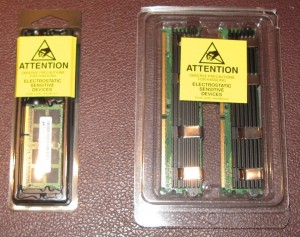
What is RAM and what does it do? RAM, which stands for Random Access Memory helps your computer process information. Sometimes a slow computer is due to the fact that your computer needs more RAM.
You may be asking something like, “That’s what the processor does though right? “ That’s a common question and yes the processor is mainly responsible for doing exactly just that processing information, but RAM helps the processor out by storing temporary information that the processor needs while it is doing something else.
What do you mean doing something else? A good way to look at this might be the CPU or processor can only do so much at one time and it needs help at times to be able to think. So the processor starts reaching its limits and says, “Go away kid you’re bothering me.” Then the information that’s needs to get processed says,” Ok I’ll go hang out with my friends in the RAM!” Eventually the processor says, “Okay I’m done doing what I was doing you can come out of the RAM now.” Pretty simple right?
“My computer has enough RAM it says 2 GB of Ram needed to run Windows, the Computer came with 2 GB from the factory and, it still runs slow.” Computers when bought at a retail store, or from the manufacturer sometimes ship with the bare minimum amount of RAM needed to run period. This is why a salesman will usually ask you if you’d like to upgrade the RAM before you take it home. This way you can surf the web, and run many other programs all at the same time and not have your computer crash, or slow down.
If you’ve a fan of cars you can think of it this way: You bought your car at the dealer, and you took it to the drag strip. Time and time again, you keep loosing to the same car over and over again. Although you did buy a really nice car, with a lot of horsepower, you have the stock motor, and the Civic that keeps beating you has bigger injectors, and Ram air etc…….If you want to beat it its time to do some work to what you just bought, and maybe take some driving lessons. So maybe even though you bought a great computer, your friend’s computer can do more then yours can, and its 2 years older. Maybe they have more RAM.
“How do I know how much RAM I need? “ Every software manufacturer puts specifications, or “System Requirements” on the side of the box, or posts it on their website. For Example Windows 7 system requirements are:
- 1 Ghz or faster Processor 32 bit (x86) or 64 bit (x64) this is the processor requirements
- 1 GB RAM (32 bit) / 2 GB RAM (64 Bit) RAM requirements are on this line.
Although there are more things that are sometimes in the system requirements we are just concerned about the RAM here. If you have any questions about how much extra RAM you need to improve your computers performance 1 or 2 GB extra will usually be enough for you. RAM is usually inexpensive for most desktop, and laptop computers, and is a simple cost effective upgrade.
You can upgrade the RAM yourself if you feel confident installing it. You d need to remember that once you open your computer you’re at fault for any damages you might do. So please ground yourself with a grounding strap and follow proper grounding procedures, or you may damage your computer. See the link if you would like to know about ESD and grounding: http://www.computerhope.com/esd.htm. Another thing to consider when installing RAM is make sure you aren’t forcing it in when you install it. It has an alignment notch or tab and only goes in one way, forcing it can damage the RAM, and your computer. So if you really don’t feel comfortable doing this, have someone else who knows what they are doing do it for you.
If you have any questions about RAM still feel free to ask a computer technician. Or search the Internet for more detailed information on RAM, and how it works, in greater detail.
